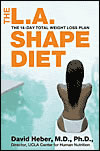Battle of the Weight Loss Books

PAGE 3
The L.A. Shape Diet
By David Heber, MD, PhD
Heber is the founding director of the Center for Human Nutrition at the University of California at Los Angeles, and he based the book on a weight loss plan he developed for himself, then adapted for his patients. Heber's diet is very low in calories and requires that 29 percent of them be protein. He also recommends that for the first week or so, much of the protein come in the form of twice-a-day shakes packed with fruit, milk, protein powder, and a meal-replacement powder containing essential nutrients. For dinner he offers standard healthy fare, such as oven-fried fish served with steamed veggies. In the second week, solid food can be substituted for the lunchtime shake, but the liquid breakfast remains. Much of the book is devoted to exercise, meditation, motivation, and how to adopt a healthy lifestyle.
What the experts like: The L.A. Shape Diet promotes a wide variety of fresh produce, "and it really talks about the importance of exercise," Nelson says. Christina Economos, PhD, also praises the lengthy discussion of how to prevent a relapse, which many diet authors neglect.
What they don't like: The biggest drawback is the diet's overreliance on shakes. "People like taste and textures," Nelson says, and some studies have shown people to be more satisfied when they eat solid foods versus liquids. Also, Economos points out, buying all the powders and supplements could get expensive.
Crunching the numbers: Very low calorie, around 1,100 per day, with double the amount of recommended protein. There's plenty of fiber and not too much fat, but the diet is lacking in vitamin E and calcium.
By David Heber, MD, PhD
Heber is the founding director of the Center for Human Nutrition at the University of California at Los Angeles, and he based the book on a weight loss plan he developed for himself, then adapted for his patients. Heber's diet is very low in calories and requires that 29 percent of them be protein. He also recommends that for the first week or so, much of the protein come in the form of twice-a-day shakes packed with fruit, milk, protein powder, and a meal-replacement powder containing essential nutrients. For dinner he offers standard healthy fare, such as oven-fried fish served with steamed veggies. In the second week, solid food can be substituted for the lunchtime shake, but the liquid breakfast remains. Much of the book is devoted to exercise, meditation, motivation, and how to adopt a healthy lifestyle.
What the experts like: The L.A. Shape Diet promotes a wide variety of fresh produce, "and it really talks about the importance of exercise," Nelson says. Christina Economos, PhD, also praises the lengthy discussion of how to prevent a relapse, which many diet authors neglect.
What they don't like: The biggest drawback is the diet's overreliance on shakes. "People like taste and textures," Nelson says, and some studies have shown people to be more satisfied when they eat solid foods versus liquids. Also, Economos points out, buying all the powders and supplements could get expensive.
Crunching the numbers: Very low calorie, around 1,100 per day, with double the amount of recommended protein. There's plenty of fiber and not too much fat, but the diet is lacking in vitamin E and calcium.



